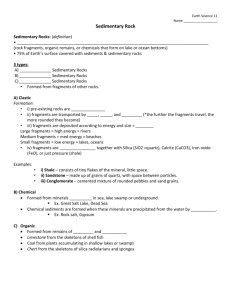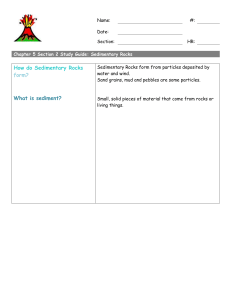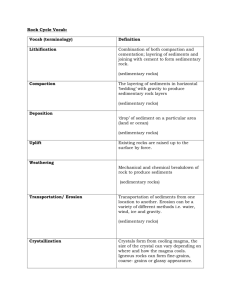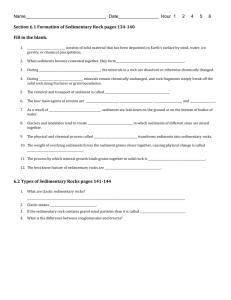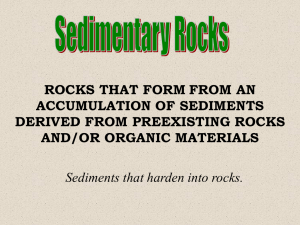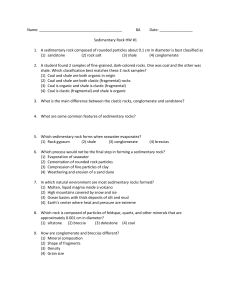Chapter 6.4: Sedimentary Rocks
advertisement
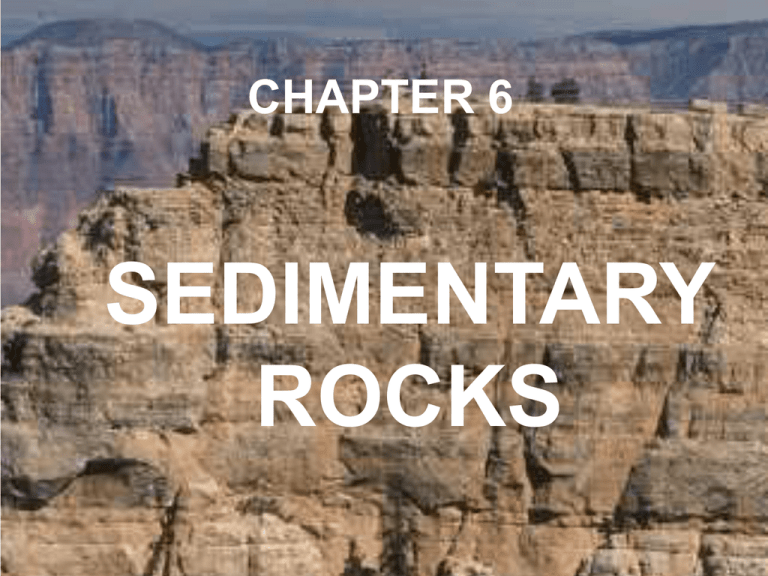
CHAPTER 6 SEDIMENTARY ROCKS Materials that make up sediments • Weathered Rocks • Organic Material • Mineral Fragments Ways sedimentary rocks can form • Compaction and cementation of sediments • Evaporation of a solution • Precipitate from a solution Kinds of sedimentary rocks 1) Clastic/Detrital – Composed of fragments and small pieces of rock (clasts) – sometimes show layering – Make up more than 85% of all sedimentary rocks – Ex) sandstone, siltstone, shale Fragments • Round Fragments = CONGLOMERATE • Angular Fragments = BRECCIA – (pronounced Brechia) – (“cc” is “ch” like Gucci) Types of Clasts • The formation of clastic rocks begins with the movement and relocation of fragments. • The majority of these are moved by running water. • Larger pebbles and gravels are often the first to be dropped and settle in shallow water near the shore. • Next to settle are the smaller sands. • Finally, in calm water, the silts and clays. Formation of Clastic Rocks • Loose sediments become solid rock when sediments become cemented. • Ocean water, lake water, and ground water all contain natural cements in the form of dissolved mineral. – Silica (SiO2), calcite (CaCO3), iron oxide (Fe2O3), and clay minerals. • When minerals fill in the spaces between sand grains, pebbles, or other rock particles, they bind the fragments together through cementation. • The type of cement influences the rock’s color. 2) Organic – Contains the cemented (lithified) remains of once living things – Sometimes contain fossils – Ex) coal 3) Chemical • Form by precipitation or evaporation of a solution • Often contain crystals or appear “dried up” • Ex) rock salt 4) Bioclastic • Composed of broken shell fragments and similar remains of living organisms • Ex) limestone Features of Sedimentary Rocks • Stratification – The arrangement of visible layers. – The most characteristic feature of sedimentary rocks. – Results from the change in the type of sediment being laid down in one place. • Fossils – The remains, impression, or any other evidence of a plant or animal preserved in rock. – Occurs when a dead organism is buried by sediment that gradually turns into rock. – The soft parts of the organism decay; the hard parts become rock. Stratification and Fossils Features of Sedimentary Rocks • Ripple Marks – Common feature of sedimentary rocks. – Sand patterns formed by the action of winds, streams, waves, or currents. – Ripple marks are generally preserved in sandstone. • Mud Cracks – Common feature of sedimentary rocks. – Develop when deposits of wet clay dry and contract. – The cracks are filled in with different solutions and fossilize. – Generally form in shale. Ripple Marks and Mud Cracks Features of Sedimentary Rocks • Nodules – Hard lumps of fine-grained silica – Found in limestone and chalk. • Concretions – Round solid masses of calcium carbonate. – Found in shale. – Both Nodules and Concretions form when minerals in a solution precipitate around a fragment in the clay sediment. Nodules and Concretions Geodes – Spheres of silica rock. – Generally found in limestones. – Groundwater creates cavities in limestone and minerals in the groundwater concentrates in the cavities to form crystals.


